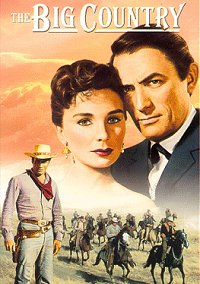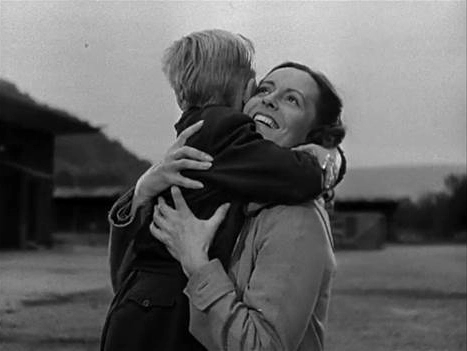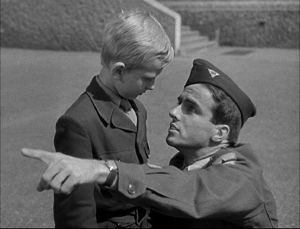How Classic Movies Help to Renew Civic Engagement for Ourselves and the Rising Generation
- Onalee McGraw

- Dec 12, 2023
- 9 min read
Updated: Jun 24, 2024
by Onalee McGraw, Director, Educational Guidance Institute

Introducing a New Curriculm From
Educational Guidance Institute
Teaching and Learning Civic Engagement
through the
Art of Classic Film
Conversing with the rising generation in the classical mode of moral inquiry
The great movies of Hollywood's Golden Age turn out to be one of the very best ways to have essential conversations about the meaning and purpose of life and the nature of our shared human condition. Collectively, and one at a time, they give us an aesthetic storytelling framework to engage together in probing the answers to these deep existential questions of life.
Delving deeper into the mysteries of our shared human nature is an essential first step for teaching and learning Civic Engaement for the generation born into the internet age. A few months ago, Oscar winner Richard Dreyfuss introduced Mr. Smith Goes to Washington on Turner Classic Movies with the message: We must return civic education to its proper central place in our nation's schools. The study of classic films in and outside the classroom is one of the very best modes of recovering national unity. It allows us all to realize the goal of rebuilding social capital in the intersections of community and culture where we live. Classic Movies work because - viewing and conversing about them - we are able to combine seeing, thinking, and experiencing community all at the same time.
Unit One
Engaging in the classical mode of moral inquiry with:
It's A Wonderful Life (1946), 12 Angry Men (1957), Remember the Titans (2000), Mr. Smith Goes to Washington (1939) and No Way Out (1950)
Making sense of the Transcendental Goods We See & Cherish Together
Experiental Learning of:
JUSTICE 12 Angry Men
COMMUNITY It's A Wonderful Life
SOLIDARITY Remember the Titans

JUSTICE as a discoverable, shared GOOD vital for a free society.
Courage is the civic virtue required for civic leadership.

When we see Eustace counting the money in the final scene, we know that it isn't the same as if it were Potter counting it. The ethos of COMMUNITY shines through with the charity of the town's generosity.

SOLIDARITY prevails through moral decisions against tribalism. Coach Boone challenges his players to rise above tribalism and come together for the greater good.

Our Civic Engaement curriculum will feature Jonathan Haidt's elements of Moral Foundations Theory (as he explains it in The Righteous Mind) applied to Mr. Smith Goes to Washington, No Way Out and Remember the Titans
One Element of Moral Foundations Theory:
Our innate sense of a Sanctity of the Good
"I can't kill a man just because he hates me"
With these words, Sidney Poiter's character affirms the timeless civic virtue of justice - and human dignity and our power to love and do the good - long ago expressed in Sophocles' Antigone

Unit Two
Depictions of Culture as the Common Way of Life of a People:
It's A Wonderful Life (1946), A Raisin in the Sun (1961),
& A Tale of Two Cities (1935)
In our fragmented cultural life today, we are challenged to share with the rising generation what it really means to live together in a culture oriented to the ethos of community as opposed to the ethos of atomistic individualism. We argue that the aesthetic imagination at work in great classic literature, drama, and film has a mysterious power to inspire the moral imagination. The term moral imagination originally comes from Edmund Burke, 18th century political philosopher. The term conveys the sense that human persons have the capacity as social beings to visualize how the good life can be lived according to shared moral norms and standards that can be known, lived and passed on to succeding generations.
Our civic engagement curriculum is designed to meet the needs of the rising generation at the middle school, high school, and higher education levels. With all of the film selections available in the curriculum , educators and facilitators implementing the program can integrate their personal knowledge of their students' experiences with their assessments and judgments in selecting films to highlight.
(The curriculum in Unit Two will feature a 2 page handout giving an account of Jimmy Stewart's experiences in WWII and in the making of It's A Wonderful Life. The beautiful thing about It's A Wonderful Life is that it fits within any unit or series of films that you would want to share at any level).
"This country's conscience is bigger than all the studios in Hollywood put together, and the time will come when we'll have to fight.” -Jimmy Stewart

"For me, reason is the natural organ of truth; but imagination is the organ of meaning" -C. S. Lewis


Unit 3
Autonomous Selves or Acting Persons?
Case Studies of Radical Choices in the Crossroads of Life:
On the Waterfront (1954), Key Largo (1948), and Bad Day at Black Rock (1955)
As our political landscape grows ever more filled with deep cleavages, sometimes the very ground upon which we are walking on seems to tremble. These films depict the view of citezenship we must renew to maintain our political community: the idea that we all carry moral responsbility for each other.
Close Up on Radical Choices in On the Waterfront
Marlon Brando's character, Terry Malloy, is assisted by Karl Malden's Father
Barry and Eva Marie Saint's Edie who persist in guiding him to make the right moral decision. Like so many great films of this era, On the Waterfront affirms the idea that none of us are isolated selves - rather we are dependent on others us to help us as we face moral decisions.
Unit 4:
Civic Virtue and the Common Good On the Line in 5 Classic Westerns:
High Noon (1952), Shane (1953), 3:10 to Yuma (1957), The Big Country (1958), and The Man Who Shot Liberty Valance (1962)
The genre of the classic western film began with John Ford's Stagecoach in 1939 and winds up with his The Man Who Shot Liberty Valence made in 1962. In each film in this unit, the action is centered in a political community somewhere in the American West in the time frame that stretches from the civil war to the end of the 19th century.
The stories all take place in a world the audience sees is a world within a larger moral order. The themes we see in these stories are neither utopian nor individualistic. Rather they show the human condition as fallen and far from perfect, yet capable of knowing and choosing the good; the characters navigate the geography of good and evil. Utopia means "no place," but the audiences of these great films in particular, see characters living life in concrete communities in the American West. A big part of the action is certain characters stepping up to become citizen leaders caring and defending the common good, and knowing when the common good is what is at stake.

Unit 5
Civic Friendship as the Morter for Building a Free Soceity:
The Films of Jimmy Stewart
In the era of atomistic individualism we are living through today, the Ethic of Community very often will lose out to the Ethic of Utility. In the Ethic of Community the moral currency is true friendship and solidarity. Aristotle famously said that "without friends, no one would choose to live" but for this generation born into the era of the internet, the currency of pragmatic transaction all too often prevails.
“After what we have said, a discussion of friendship would naturally follow, since it is a virtue or implies virtue, and is besides most necessary with a view to living. For without friends, no one would choose to live, though he had all other goods” (Aristotle, Nichomichean Ethics pp 7).
Consider this great philosopher’s quote in light of Jimmy Stewart’s It’s A Wonderful Life!
“No man is a failure who has friends”
This unit works well for middle school, high school, and college students. The beauty of classic movie storytelling is that in its very essence, this art form reaches every human heart. Since we are all very diffedrent and yet share a common humanity, there is this mysterious flow that pulls us along in the story through the beginning, middle, and end. Aristotle wrote about this in his Poetics, discussing how the audience experiences a catharsis through their encounter with the story.
Richard Dreyfuss shared with the New York Film Academy several years ago,
“The thing that makes acting unique is that of all the art forms acting is the only one that does THAT! It can hit you so fast it’s like someone can rip into your chest, take your heart out, throw it on the floor, throw it back into your chest in one second, and you burst into laughter, burst into tears, and only acting can do that.” -Richard Dreyfuss
Case Study of True Friendship: Jimmy Stewart's Biopic, Carbine Williams
If there is one actor from the Golden Age that today's generation might have heard of, it's Jimmy Stewart. Recently, we were with a group of high school students who viewed and discussed Carbine Williams. This film is excellent to share with the youth of today because it dramtizes the three philosophies of life - atomistic individualism , fatalism and classic realism - lived out by the title character Marshall "Carbine" Williams. This Jimmy Stewart biopic of "Carbine" Williams was based on the Reader's Digest article, The Most Unforgettable Character I've Met by Capt. H. T. Peoples. Williams was sentenced to thirty years hard labor, charged for killing a federal agent during the Prohibition Era. While he was in prison, Williams invents a new rifle that is significantly lighter in weight. Eventually, with the help of his good friend, Warden Peoples, Williams is pardoned and goes on to perfect the rifle that was carried by our troops in World War II.

As the film shows, Williams had highly complex relationships with his father, wife, and son. Initially trapped in a fatalist mode, Williams' friendship with Warden Peoples makes all the difference. In EGI's study guide, The Films of Jimmy Stewart, a lesson plan is featured on Carbine Williams and Three Philosophies of Life. This was the only film in which Jimmy Stewart played a character who actually adopted all three philosophies in his lifetime. He begins in atomisdtic individualism, falls into fatalism, and finally walks the Aristotelian road of classic realism.
Unit Six
Our Human Condition Across the Generations
The Russians are Coming, The Russians are Coming (1966), Fiddler on the Roof (1971), Hoosiers (1986), What About Bob (1991) and Rembember the Titans (2000)


"We are all in the same boat in a stormy sea, and we owe each other a terrible loyalty"
-G. K. Chesterton
Unit 7
Advanced Study on the era of World World II
The Seventh Cross (1944), The Search (1948), Judgement at Nuremburg (1961), and Little Boy (2015)
"The really frightening thing about totalitarianism is not that it commits 'atrocities' but that it attacks the concept of objective truth." -George Orwell
The Search was the very first American film directed by Fred Zinneman. He went on to direct High Noon, A Nun's Story, and A Man for All Seasons

This photo was taken in April, 1945 by Major Clarence Benjamin and shows a train of Jewish prisoners that had been intercepted by Allied Forces. This is the moment they learned that the train would not be heading to a Concentration Camp and they had been liberated.
Unit 8
We Still Do "Hold These Truths"
Questions to ponder as we embark on the joureney to restore Civic Engagement in our postmodern world
Part One: What can we learn about our human nature from what the Founders said?
"We hold these truths to be self-evident, that all men are created equal, that they are endowed by their Creator with certain unalienable Rights, that among these are Life, Liberty and the pursuit of Happiness.--That to secure these rights, Governments are instituted among Men, deriving their just powers from the consent of the governed..." -The Declaration of Independence
The Founders were not all the same. They had various religious and philosophical outlooks, and yet there was among them a unifying sense of what was right and good for the blossoming country they envisioned. Consider Jefferson's reference to "the harmonizing sentiments of the day" (letter to Henry Lee, 1825), clearly referring to the body of thought of political philosophy that grounded the American founding.
Part Two: Essential truths about human nature discovered in the films of the five directors who came back after WWII as chronicled by Mark Harris in Five Came Back

The account given by Mark Harris in Five Came Back is a way of entering into the common world of American culture in the era of World War II - including both pre-war and post-war years. Five legendary directors show their poetic genius to depict America as a cultural common home through their films. Harris - with his amazing ability to interview and delve deeply into archives - tells the story of these five as they served in World War II. As Harris says:
"Filmmakers could not win the war, but Capra, Ford, Huston, Stevens and Wyler had already shown that they could win the people. That was more than enough to secure the five men --the most influential and innovative film directors to volunteer for service --a place of critical importance in the war effort"
(Five Came Back, page 11).

Appendix:
More quotes from the Founding Era to explore our shared human nature.
Special presentation materials based on the research of Jonathan Haidt, Jean Twenge, Yuval Levin, Robert Putnam, and others.
Bibliography:
Suggested reading from across the disciplines of film history, political theory, psychology, sociology (e.g. The Federalist Papers and the Nichomichean Ethics)















































Comments